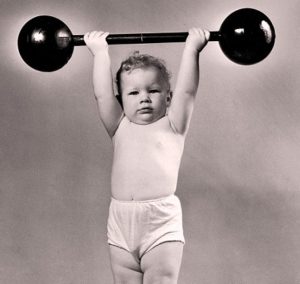The last thing a concerned parent wants to do is stunt the growth, or possibly injure, their young children.
However, a lot of the negatives behind strength training are untrue, and rooted in what amounts to old wives tales.
The Force is Strong with This One…
 When I was growing up (a looooonnnnnggggg time ago), the argument against strength training was that it would stunt your growth.
When I was growing up (a looooonnnnnggggg time ago), the argument against strength training was that it would stunt your growth.
Yet, there really wasn’t any literature to support this. It’s just something that well meaning doctors and scientists threw out there because it made sense.
But what these well-intentioned people failed to realize is that the stresses in sport far exceed what happens in the weight room!
For example, in strength training a good measure of strength would be if you could squat or deadlift 2x your body weight. In other words if you weighed 175, if you could squat and/or deadlift 350, you’d be considered strong.
However, the forces that you see in everyday events like running (4-6x body weight) and jumping (6-10x body weight) far exceed anything done in the weight room.
Oh and by the way – they’re doing those things hundreds of times every single day!
To me, the forces involved in strength training aren’t worrisome. After all, they’re loading and stressing their body far more in normal athletic activities than they are in the weight room.
The big issue for me are the external loads involved in strength training, combined with a lack of technique built around it.
Good Technique, You Must Have…
The big issue with most young athletes when they come into the gym is technique.
Here’s a really important point: Lifting weights is a skill.
Just like you have to learn how to run or jump, you need to learn how to lift weights as well.
Too often, parents and coaches see a kid and want to push their development.
They want to make them bigger, faster or stronger.
And as a result, they want to push the loading before that skill is firmly in place.
For me, athletes could start learning the basics of strength training as young as 10 or 11 years old. That doesn’t mean they’re in the gym grinding out heavy squats and deadlifts at that age, but they can learn the technical elements of the lifts.
This class sesssion would revolve primarily around movement, games, and developing general athleticism. The strength training piece would be short and sweet, and would focus on them controlling their body in various postures and positions.
Furthermore, there’s a ton of value in starting young. The younger an athlete starts to learn a skill, the easier it is to shape and mold it before they learn it the wrong way!
(Sad side note: I can’t tell you how many kids we get at IFAST that we’ve had to totally break down because they were taught the wrong way to lift. If you’re unsure, please find someone qualified who can help!)
The real question becomes, at what age do you really start pushing the weights?
If I had my perfect world, it would look something like this:
Step #1
Around 10-12, a young athlete would start the formal developmental process.
Again this would focus primarily on games, learning to “own” their own body weight, and a basic focus on how to squat, lunge, push-up, etc.
Step #2
From 12-15, the focus would continue to be on games, but now you can start to push strength training a bit more.
Adding in external load to those big movements will coincide with the massive amount of hormones that their body is naturally producing, and also start to build a base for future training.
Vladimir Zatsiorsky often states than an athlete needs a 3-year introduction to strength training before any maximal loading should occur.
Build a base early-on, so that your athletes can develop fully over the long haul. You can’t rush this process!!!
Step #3
From 15-16 on, that’s where you can get serious with loading and strength training (assuming the 3-year rule has been adhered to.)
Now people get tentative when I say that, but with athletes it’s not about how much weight you can push.
Instead, it’s how much weight you can push:
- With good technique, and
- With the focus on that strenth carrying over to their sport.
Unfortunately, it’s easy to get seduced into thinking that moving heavier and heavier weights is somehow going to transfer over to improved sports performance.
While strength does carryover to speed and power development up to a point, you can definitely go too far and end up looking (and moving) like a powerlifter.
Keep in mind, all of these are general timelines, and would be specific to the individual child. If you want to learn more about the timing of this, check out this article on peak height velocity.
Summary
Strength training, when done correctly, is absolutely safe and effective for young athletes.
The goal is to get them started early, focus on technique and proper movement, and only push the loading once the skill of lifting weights is firmly in place.
I hope this helps and gives you some insight as to the best ways to develop your child!
All the best
MR
P.S. – If you want more information on this, please check out the work of Istvan Balyi. He’s a pioneer on this front, and has literally provided a step-by-step process in his book Long-Term Athletic Development.
0 Comments
Join the conversation